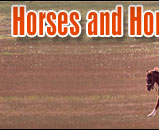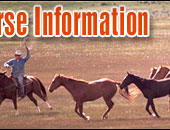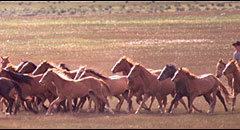 |
   |
|
|
|
You are here: Horses > Horse Care > Bathe your horse |
Guide to Proper Horse Bathing, Equine Grooming and Basic Cleaning
Bathing your horse is a time consuming yet necessary
activity that will make for a presentable animal at a show
and that will leave the animal that has just made it through
a winter looking once more shiny and clean. |
|
|
The logistics of washing and shampooing a horse do require
some pre-planning in order to avoid common mistakes that
will cost you time and most likely also try your patience.
Begin by picking out a spot that will not turn into a muddy
mess as soon as you turn on the water. Similarly, find an
adequate post to which to tie the horse and gather the
supplies you will need. Consider wearing clothes that can
get wet without leaving you soaked to the skin; find some
rubber gloves to protect your hands, and get the shampoo. |
 When it comes to selecting the proper shampoo for your
horse, you will need to resist the urge to simply use
regular cleaners that are not specially formulated for these
animals. If you wash your horse frequently, you will need to
select a more gentle shampoo than if you only do so upon
occasion. Additionally, there are several different shampoo
formulas available, depending on your need. Purchase the
kind of shampoo that matches your horses’ needs the best.
Shampoos formulated for horses are pH-balanced for the
animals’ sensitive skin which is also host to a number of
beneficial bacteria which – if damaged or destroyed – will
lead to severe skin problems. When it comes to selecting the proper shampoo for your
horse, you will need to resist the urge to simply use
regular cleaners that are not specially formulated for these
animals. If you wash your horse frequently, you will need to
select a more gentle shampoo than if you only do so upon
occasion. Additionally, there are several different shampoo
formulas available, depending on your need. Purchase the
kind of shampoo that matches your horses’ needs the best.
Shampoos formulated for horses are pH-balanced for the
animals’ sensitive skin which is also host to a number of
beneficial bacteria which – if damaged or destroyed – will
lead to severe skin problems.
Once you have chosen the proper spot to wash your horse and
the animal is securely tied to a post, mix the shampoo with
lukewarm water in an easily accessible bucket. The amount of
water will depend on the concentration of the shampoo – be
sure to follow the directions! Beginning with the animal’s
feet and working upward, hose down the horse slowly and
gently until you finish by wetting its back. After the
animal is completely wet, use a sponge to transfer the soapy
water to the animal. Work in the shampoo with a grooming
mitt and do not be afraid to take your time until you are
certain that the dirt, grime, and dead skin cells have been
worked out. Hose away dirtied suds and apply soap once more.
Ensure that the parts of the horse that have been shampooed
do not dry out but instead keep them adequately moist.
Keeping in mind that horses detest having their heads
washed, be sure to use less shampoo so that you will have to
do less rinsing. Cleansing of the nostrils and the inside of
the ears should be done with a moist cloth. The tail can be
immersed in a bucket of soapy water and then massaged in the
same way that you would shampoo the hair on your head. A
specially formulated conditioner for the tail and mane will
round out the bath.
When you are ready for a final rinse, it is important to
begin at the top and work your way down, being sure to wash
out all of the shampoo to avoid a dull looking coat and
irritated skin. While you are rinsing off the animal,
continue to employ the grooming mitt. After the final rinse
you will be able to remove excess water with a sweat scraper
before you towel dry the animal. Some horse owners find that
walking the animal after a bath until the coat has dried
will minimize the chances of the horse rolling in dry, dusty
hay to get dry.

|
Read the next horse care article on Clipping / Shaving Your Horse's Hair. |
|
|
|
|
 |
|
|
|
|
|
Horse Education
|
|
|
|
|
Horse Information Topics
|
|
|
|
|
|
|
|
Horse Business Owners
|
| |
Advertise with Us
Have your horse products or services exposed to over 27,000 of our monthly visitors.
|
|
|
|
|
|